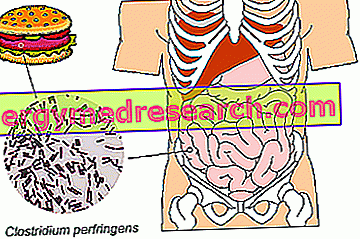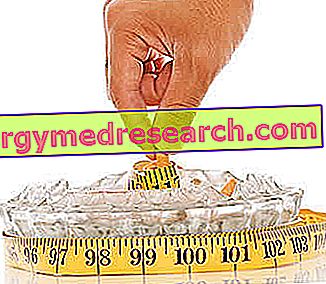Presentation of the bacterium
Clostridium perfringens is a bacterium protagonist of numerous food poisonings; to speak in more specific terms, enterotoxins produced by Clostridium perfringens can trigger a food poisoning - normally not dangerous - after the ingestion of contaminated food. The pathogen, after an incubation time varying from 8 to 16 hours from the intake of the infected food, triggers typically gastrointestinal symptoms (diarrhea and abdominal cramps): for this reason, we speak of Clostridium perfringens enteritis , an intestinal inflammation which tends to self-cancel within a few (24) hours. Before analyzing the details of the infection triggered by this pathogen, let us examine its general microbiological characteristics.
Microbiological description

Clostridium perfringens, like all the other bacteria belonging to the same category, has a rod-like shape, it is a flagellated micro-organism, therefore mobile, and only rarely capsulated; to complete the general description, the bacterium is sporogenous and anaerobic (it lives in the absence of oxygen). The bacteria of the species Clostridium perfringens are able to reduce sulphites in sulfides, and produce stable and thermoresistant spores in the environment.
Some strains of Clostridium perfringens (NOT spores) are particularly sensitive to temperatures, unlike others, which tend to withstand the action of heat; the spores - let us remember again - are almost always thermostable (they resist heat).
Clostridium perfringens in nature
Clostridium perfringens is almost ubiquitous in nature; it is available in decomposing plants, in the intestines of mammals and vertebrates, in insects and in the vast majority of the soil. It is estimated that in human feces the bacillus is present in concentrations that fall between 102 and 107 CFU / g (where UFC stands for Unit Forming Colony); high levels of Clostridium perfringens are also found in faeces of pigs and dogs, while in other warm-blooded animals the presence of the bacterium is minimal or even absent. It is estimated that the concentrations of this bacterium in wastewater are around 105 CFU / ml; however, modern water purification systems reduce the bacterial load by 95-98%.
For the qualitative evaluation of foods, the determination of Clostridium perfringens is certainly a parameter that should not be underestimated. The detection of the bacterial load in water intended for consumption, for example, is an indication of both the organoleptic / microbiological quality of the food and the efficiency of the purification treatment to which the waters have been subjected.
Food poisoning
As previously mentioned, Clostridium perfringens is one of the major culprits of food poisoning, and therefore of food poisoning. With heat treatment, Clostridium perfringens and many other bacteria succumb, but not their enterotoxins which, remaining unchanged, cause gastrointestinal damage in humans.
MODALITIES OF TRANSMISSION: The infection with Clostridium perfringens is transmitted to the man through ingestion of contaminated foods, above all meats, poultry and elaborated fishes. Following the preparation, if the food remains at room temperature for a long time, the spores, producing toxins, can originate new vegetative forms: precisely, immediately after ingestion, the spores germinate in the digestive tract of the host, synthesizing precisely a new toxin. The effects of the toxin originating inside the body, added to those of the preformed toxin (inside the food) trigger the Clostridium perfringens toxinfection.
Note:
- Food cooking → heat-resistant spores survive and find themselves in an anaerobic status (a consequence of thermal action)
- Subsequent storage of the food at a temperature of 106 clostridia / gram) → manifestation of the symptoms of Clostridium perfringens
Infection symptoms
After 8-16 hours from the ingestion of food contaminated with Clostridium perfringens, the subject begins to complain of typically gastro-intestinal symptoms, such as abdominal cramps and profuse diarrhea, sometimes associated with fever and vomiting. Prodromes are generally resolved without the need for treatment in 24 hours.
The prognosis is good in the vast majority of cases, and treatment is purely symptomatic; many patients do not need any medication, since pathogens and toxins are easily eradicated in a few hours.
Only rarely, Clostridium perfringens causes serious complications in humans; however, it appears that a strain of this bacterium ( Clostridium perfringens type C ) is responsible for a severe form of intestinal inflammation, known as necrotizing enteritis. Complications are the expression of beta-toxin production, produced exclusively by Clostridium perfringens type C, potentially capable of developing ulcers, fulminant toxaemia, dehydration, shock and death.
Prevent food poisoning
Risk factors NOT negligible: the slow cooling of the food, after cooking, is a critical element that favors the disease → The thermal abatement, immediately after cooking (or precooking) the food to be preserved, is a fundamental preventive form for avoid food contamination. This very important preventive practice must always be respected, especially in canteens, being places where food is often prepared many hours before actual consumption.
The scrupulous respect of the rules of food handling and preservation - therefore the fine tuning of what is described in detail in the HACCP model - minimizes the risk of developing food toxinfections, including that triggered by Clostridium perfringens .



